The Ultimate New Zealand Soccer Website | home
OFC Women's World Cup | OFC Olympic Women's Football Tournament | Oceania Nations Cup | OFC U-17 & U-19/20 Women's World Cups | OFC Women's Player of the Year | History | Youth (U-15) Olympic Games | OFC Ambassadors | Pacific Women's Four Nations | South Pacific Games | OFC Women's Champions League | Australia
History
Women’s Soccer In Oceania - A History
by Jeremy Ruane
The first involvement of Oceania nations in women’s soccer came about in 1975, when New Zealand and Australia were invited to participate in the Asian Cup, which was being held in Hong Kong.
To this point, New Zealand had never played at international level, the first officially recognised leagues in this country having been established in 1973. The prospect of playing at international level had a unifying effect on the country’s women’s associations, however, and the New Zealand Women’s Football Association was formed just prior to the country’s participation in the Hong Kong tournament.
History will show that the Kiwis went on to triumph in their first-ever foray in international women’s soccer, the Asian Cup heading east of Down Under as a result of a 3-1 win over Thailand in the final. En route to the ultimate stage, New Zealand downed Australia 3-2 in the first-ever trans-tasman battle.
After a four-year hiatus, rivalries were resumed in 1979, with both the Kiwis and the Matildas winning a match in the three-test Trans-Tasman Cup series, with the other being drawn.
The first instance of the other Oceania nations becoming part of the women’s soccer scene in the region came about in 1983, with the advent of the Oceania Cup. The first tournament was held in New Caledonia prior to Christmas that year and, as was to be expected, both Fiji and the host nation suffered at the hands of their more experienced contenders, with the Fijians copping a couple of double-figure hidings.
As with their first venture in the Asian Cup, New Zealand was successful in the inaugural Oceania Cup tournament too, defeating Australia 3-2 after extra-time in the final, after the Matildas had led 2-0 at one stage.
Three years later, rivalries resumed in Christchurch at Easter, with Papua New Guinea and Taiwan - then in the Oceania region due to the political situation with their Chinese neighbours - entering the tournament.
Both Fiji and New Caledonia declined the opportunity to enter the fray in 1985, while PNG pulled out at the last minute, meaning that New Zealand were forced to field a B team, as well as their A selection.
The stretching of their resources ultimately counted against the host nation, with the visiting teams advancing to the final, where Australia’s flame was well and truly doused by the Taiwanese, whose efforts at the 1981 and 1984 World Invitational Tournaments, both of which were hosted by Taiwan, saw them unofficially ranked in the top three of women’s soccer’s elite.
At the third World Invitational Tournament, in 1987, New Zealand acquitted themselves very well indeed, finishing second-equal - fourth on goal difference - at the conclusion of the event, at which it recorded a famous 1-0 victory over a USA combination which included such women’s soccer luminaries as Kristine Lilly and Mia Hamm in its starting line-up.
Taiwan came back to defend the Oceania Cup in 1989, the Easter event this time taking place in Brisbane. Papua New Guinea also made it for the first time, with Australia taking the opportunity, as New Zealand did three years previously, to blood some of their up-and-coming prospects, by way of fielding a second team.
As had been the case in Christchurch in 1986, the host nation paid the short-term price for splitting the pack, so to speak, with neither Australian side, nor the inexperienced PNG team, making it to the final. That honour was bestowed upon New Zealand and Taiwan, with the Kiwis downing the Asian side 1-0 in round-robin play as they swept to the final without conceding a goal.
Enter the elements, the teeming rain in Brisbane combining with the efforts of the Taiwanese rearguard to repel New Zealand’s attacks time and time again. One counter-attack led to the only goal of the final, and Taiwan held onto the cup.
It was to be the last occasion that the Oceania Cup was contested, as the long-awaited sanctioning of a World Cup for women’s soccer by FIFA saw the first such finals taking place in China in 1991.
Oceania’s representatives were determined by a round-robin series in Sydney in May of that year, with Papua New Guinea proving mere cannon-fodder for the rampant attacks of New Zealand and the host nation.
In the end, it came down to goal difference, both trans-tasman rivals having beaten each other in round-robin play. And it was the Kiwis, by virtue of their 16-0 triumph over PNG - to that point, the country’s record victory - who took the slow boat to China in time for the pre-Christmas festival of women’s soccer.
Unfortunately for New Zealand, it was an even slower trip back home, made so by defeats at the hands of Denmark (0-3), eventual runners-up Norway (0-4) and China (1-4), against whom Kim Nye scored New Zealand’s only goal to date at the Women’s World Cup Finals.
The next series of World Cup qualifying action came around in October 1994, this time in Port Moresby. Again, Papua New Guinea were no match for the elite nations of Oceania women’s soccer, although they had improved to an extent - there were no double-figure hidings this time round!
Indeed, New Zealand could only muster six goals against the host nation in two games, statistics which meant that Australia represented Oceania in Sweden at the June 1995 finals, although they found the going just as hard as their trans-tasman rivals had done four years previously.
Denmark (5-0), China (4-2 - Angela Iannotta and Sunni Hughes the markswomen) and defending champions the USA (4-1 - Lisa Casagrande on target) extinguished the Matildas’ hopes of improving the region’s standing, in terms of results, on the world stage.
With the region having no involvement in the inaugural Olympic Games competition for women’s soccer in 1996, Oceania’s female footballing elite have sought to improve their standing by travelling the world to take on rival nations, as well as attracting some of them to this area of the world.
Fortunes have been mixed, to say the least. While the Matildas have recorded wins over largely second- and third-tier opposition - the obvious exception to this record being a triumph over China in pre-2000 Olympics action, they have also copped a couple of good old-fashioned hidings - the USA and Norway respectively tanked the Australians 9-1 and 7-1 in 1997.
Meanwhile, the SWANZ, whose involvement on the international stage has become somewhat irregular, to say the least, were embarrassed 8-0 by Germany a year later, a result which was part of their preparations for the 1998 Oceania Women’s World Cup qualifying series, which took place in Auckland.
For the first time, six nations contested Oceania’s lone automatic qualifying place, with Samoa and American Samoa both commencing life on the world stage by taking on New Zealand and Australia respectively, on October 9.
Both big guns recorded 21-0 triumphs over their inexperienced rivals, a scoreline which equalled the world record victory initially set by Japan over Guam in 1997 in an Asian Women’s World Cup qualifier, and later equalled by Canada in 1998, in a CONCACAF Women’s World Cup qualifying encounter with Puerto Rico.
Fiji and Papua New Guinea recorded their first international victories during the Oceania play-offs, but it was left to the big two to fight it out for a place at USA ‘99.
Australia prevailed, 3-1, but again failed to impress on the big stage. Despite scoring in every match - Julie Murray, with two, and Cheryl Salisbury were responsible for the goals - the Matildas returned home earlier than planned, following a 1-1 draw with Ghana, and 3-1 defeats at the hands of both Sweden and eventual runners-up China.
But Australia returned home assured of participating in the 2000 Olympic tournament, as hosts. The Matildas prepared for this event like none before, with a wealth of activity, including hosting the inaugural Pacific Cup tournament.
This was attended by the USA, China, Canada, Japan and New Zealand, the first games for the SWANZ on the international scene since the last Women’s World Cup qualifying series. Ultimately, their lack of experience counted against them, as narrow defeats by Canada and Japan were followed by heavier reversals against the other nations, including the reigning World and Olympic champions, for whom Christie Pearce is shown edging out Amanda Crawford.
Australia, meanwhile, scored victories over Japan and the SWANZ, and took China all the way to a penalty shoot-out, before defeats by Canada and the USA left Oceania’s two representatives in the six-team tournament firmly entrenched in the bottom half of the table.
For the Olympics hosts, it proved to be a bad omen, as the Matildas again failed to perform when the curtain lifted on the main event. A first-up 3-0 defeat by Germany left Australia needing to win their remaining matches, but a 1-1 draw with Sweden - Cheryl Salisbury the scorer, and a 2-1 defeat by Brazil, in which Sunni Hughes found the target, meant another early exit.
To add insult to injury, Australia, despite being the only country to put themselves forward to host the 2003 Women’s World Cup Finals by the closing date for such submissions, were overlooked in favour of an after-deadline bid by China, meaning that only one nation will fly Oceania’s hopes once again at the next world celebration of the women’s game.
That nation was, again, Australia, after they prevailed over the SWANZ 2-0 in the final game of the 2003 Oceania Women's World Cup qualifying series. It makes you wonder how much more competitive the Kiwi team would have been had they enjoyed as much exposure to the international scene as their trans-tasman rivals since the 2000 Pacific Cup tournament. In that time, the Matildas played twenty-four internationals. The SWANZ played none!
At USA 2003, the Matildas again promised much, but failed to deliver. After going ahead against Russia, they promptly put through their own net before conceding a last-minute winner. A draw with China gave them great hope of progressing to the next round, but against Ghana, their dreams evaporated, and another premature trip home was the result.
Australia's dominance of Oceania contiinued in 2004, greatly aided by NZ Soccer's decision not to enter their country's foremost female footballers in either the 2004 Olympic or U-19 Women's World Cup qualifying tournaments, a move which understandably led to an outcry, and left NZ's national body faced with a case involving the Human Rights Commission!!
NZS considered that New Zealand couldn't beat Australia with the players they had available to them, so they were better placed to invest their available funds in other projects ... it made sound sense financially, and the logic was understandable, but to deny the players the chance to even compete, something which goes against the grain of the New Zealand psyche full-stop?
Australia couldn't believe their good fortune, and comfortably qualified for both finals, thereby securing themselves the sort of experiences which New Zealand continues to crave.
However, at the end of 2005, Australia's involvement in Oceania came to an end, the country having been given the green light to switch confederations.
From 2006, they became part of the Asian Football Confederation, a situation which opened the door for New Zealand to take over as the queens of Oceania women's soccer, and enjoy the chance to qualify automatically for tournaments such as:
They certainly took the opportunity in terms of qualifying for the first tournament, proving far and away the best team on show at the Under-20 Women's World Cup qualifiers in Samoa.
And in Russia itself, they came within thirty seconds of holding the host nation to a draw, then scored the point their efforts deserved against no less a footballing foe than Brazil, who eventually finished third in the tournament.
New Zealand's dominance of Oceania women's football has continued unabated ever since, with the Football Ferns becoming increasingly competitive on the world stage as they gain in experience - a draw with eventual fourth place-getters Japan at the Olympic Games one of a number of highlights in recent years.
New Zealand hosted the inaugural FIFA U-17 Women's World Cup Finals in October - November 2008, and earned plaudits aplenty for the impressive manner in which the tournament was run.
On the park, the Young Ferns suffered narrow defeats at the hands of Canada and Denmark, but a thrilling 3-1 win over Columbia saw Rosie White score the first of her two hat-tricks in FIFA Finals.
The second helped clinch a 4-3 victory over host nation Chile at the FIFA U-20 Women's World Cup FInals weeks later, an event for which the Junior Ferns qualified automatically due to no other entries being received from around Oceania.
They came within thirty seconds of advancing beyond the first round - a last-gasp England equaliser denied New Zealand their second win of the tournament.
Given the island nations' only matches tend to be the qualifying tournaments for the various FIFA Women's Finals, and the increasing individual recognition being afforded their players, much like that given to Australia's finest when they were part of the Oceania Confederation, New Zealand is set to dominate women's football in the South Pacific for some considerable time.
That has proven to be the case. The Junior Ferns and Young Ferns both advanced to their respective 2010 finals without scoring a goal, while scoring 64 between them.
Come the Finals, however, they conceded nineteen between them as both teams bowed out without scoring a point, although 2-1 losses to both Sweden and North Korea (U-20s) and to Venezuela (U-17s) reflected their competitiveness.
At Germany 2011, the Football Ferns continued that trend, going down by the odd goal in three to both Japan and England - they led the latter at one stage, before coming from two goals down to strike twice in injury time and draw 2-2 with Mexico - New Zealand's first point at the Finals.
In the build-up to that event, John Herdman's side were runners-up at both the 2010 Cyprus Cup and the 2011 Matchworld Cup, and semi-finalists at the 2010 Peace Queen Cup.
Come 2012, the Junior Ferns scored a 2-1 win over Switzerland and drew 2-2 with Japan to leave themselves poised to advance to the knockout stages, but a 4-0 hiding at Mexico's hands ended those hopes.
The Young Ferns lost 1-0 to Mexico and 4-3 to Brazil, whom they led at one stage, but it was the Football Ferns who earned the plaudits.
After 1-0 defeats by Great Britain and Brazil, a 3-1 defeat of Cameroon fired Tony Readings' charges into the quarter-finals of a FIFA tournament for the first time in New Zealand's history. The reigning Olympic champions ended the dream, however, USA prevailing 3-0.
Since London 2012, Oceania's flagship women's team has continued to fly the flag proudly for both country and confederation, finishing third at the 2013 Cyprus Cup before, later that year, defeating both Brazil and China to win the Valais Women's Cup.
With results such as these - and numerous other close calls, including draws with both 2011 FIFA Women's World Cup finalists, Japan and the USA, it was little wonder the Football Ferns were untroubled in qualifying for Canada 2015.
There, but for a penalty which hit the crossbar, and a couple of dubious decisions going against them, they would have progressed far deeper into the tournament - finishing last in their group was far from a fair reflection of their performances, which saw draws with the host nation and China, and an odd-goal loss to Holland.
At age-grade level, New Zealand's was the only entry received by Oceania for the 2014 U-17 Women's World Cup qualifying tournament, so they progressed to the finals in Costa Rica, where they encountered the eventual finalists, Japan and Spain, in their group.
The Junior Ferns, however, fared far better. Comfortably qualifying for Canada 2014, they proceeded to finish second in their group, only to bow out to eventual runners-up Nigeria in the quarter-finals.
They then proceeded to smash records galore in qualifying for the 2016 Finals, winning every match by double figures, including a stunning 26-0 blitzing of New Caledonia in which Emma Rolston struck a record individual haul of eleven goals - then got substituted at half-time!
She ultimately struck 25 of the Junior Ferns' 69 goals in their four games at a tournament in which the island nations were competitive in matches among themselves - two 3-3 draws and a 3-2 thriller - but then found themselves up against a team seemingly from a different planet when they found themselves taking on the Junior Ferns!
Papua New Guinea didn't contest the Cook Islands tournament, as they have been named host nation for the 2016 FIFA U-20 Women's World Cup Finals - quite a coup for a country with relatively limited infrastructure and facilities, certainly compared with Sweden, the other contenders to host the event.
Meanwhile, the 2016 OFC U-17 qualifying tournament has attracted nine entries, a record number for that age grade, and a reflection of a lot of hard work being done by Confederation staff to raise the profile of and encourage both competition and growth in the women's game in the island nations.
One of the benefits from the Football Ferns' progress has been the number of opportunities which have become available to players to earn a living playing the game in other countries.
In 2015, nations such as Germany, Norway, Sweden, Switzerland, Japan, Australia and the USA all boast top leagues in which at least one Football Fern can be found doing what they most enjoy.
Our most successful player abroad has been Ali Riley, who has won a host of honours in Sweden, while Emma Kete is easily the most travelled footballer, having played for clubs in Australia, Canada, England, Finland, Germany and the USA, as well as in her homeland.
|
The 1975 Asian Cup champions
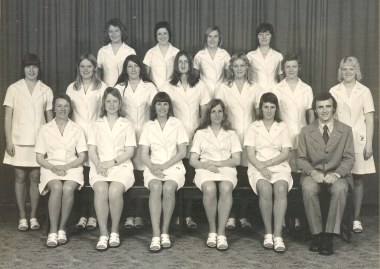 The 1987 World Women's Invitational Tournament squad
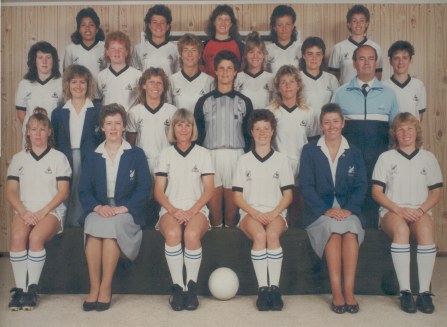 The 1991 Oceania Women's World Cup qualifying squad
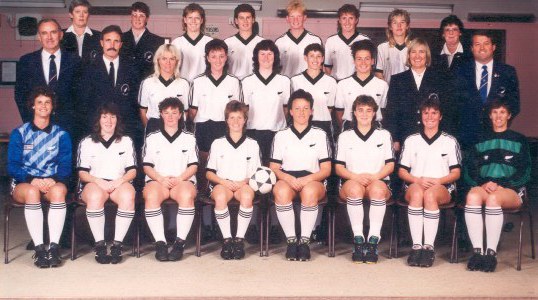 Australian legends Sunni Hughes (#10) and Julie Murray
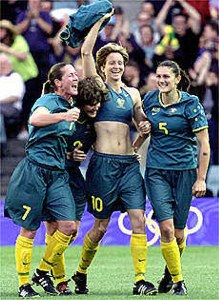 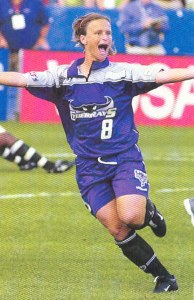 New Zealand's Amanda Crawford in action against the
USA's Christie Pearce at the 2000 Pacific Cup
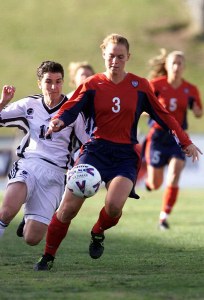 New Zealand's U-20 squad, 2006 Oceania champions
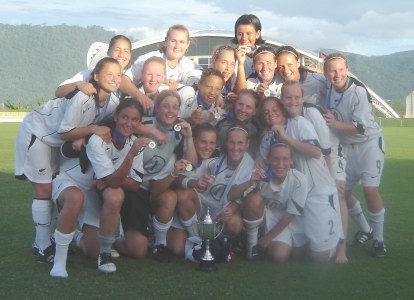 New Zealand's 2007 FIFA World Cup Finals squad
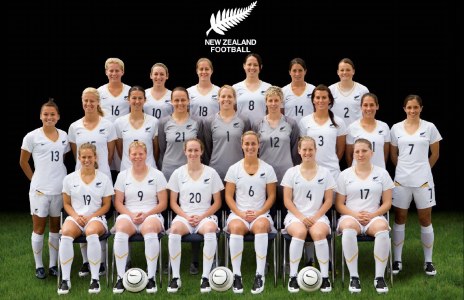 Oceania Women's Football Ambassador, Maia Jackman
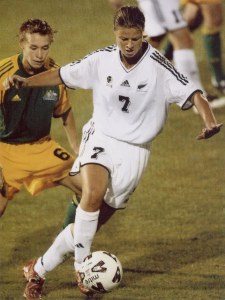 The Young Ferns squad prior to hosting NZ08
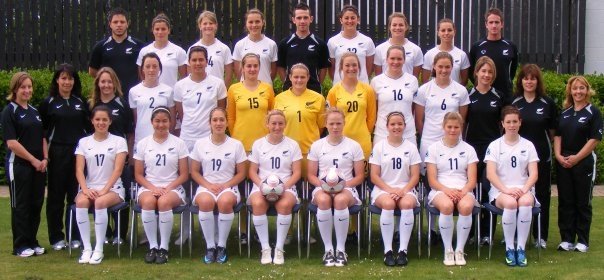 Rosie White, NZ's U17 & U20 World Cups hat-trick heroine
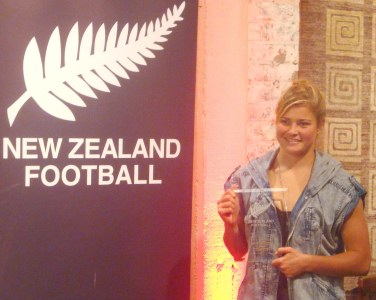 Amber Hearn scores at the 2008 Peace Queen Cup
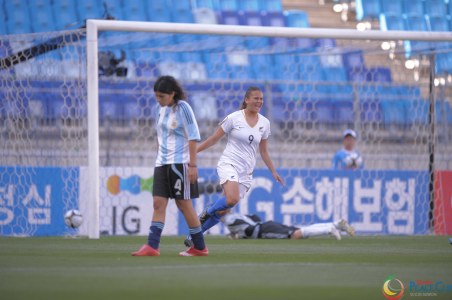 Hannah Wall during the 2010 Cyprus Cup Final
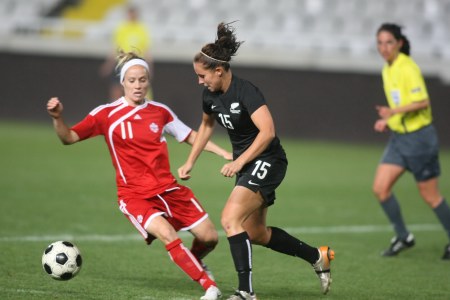 Hannah Wilkinson equalises against Mexico at Germany 2011
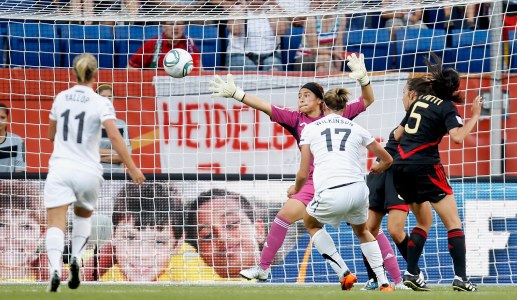 Kristy Hill leads a celebratory haka in Germany
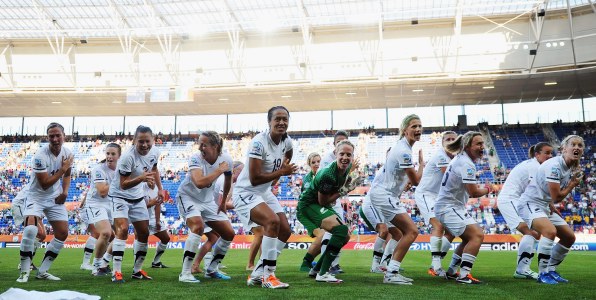 Hayley Bowden, the first woman to make 100 appearances for NZ
 The 2012 Olympic Women's quarter-final starting line-up
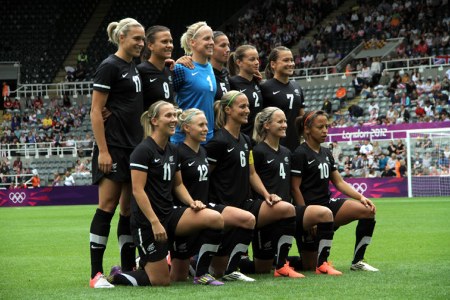 Rebecca Smith, NZ's captain on 45 occasions, with the writer
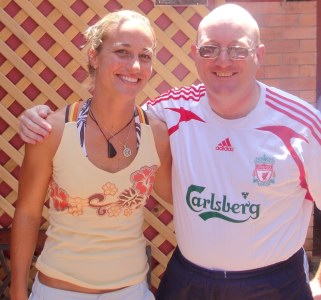 The 2012 Junior Ferns celebrate their OFC title triumph
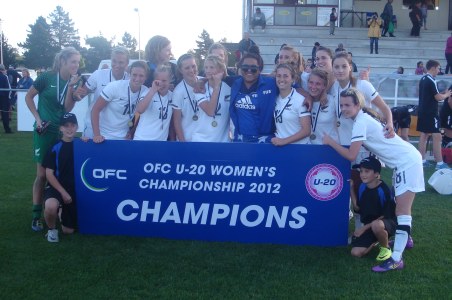 Ali Riley, NZ's most successful overseas-based star
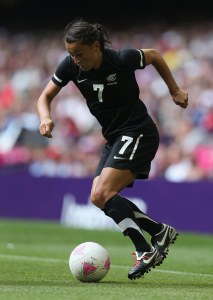 Abby Erceg, the first NZer to play in 100 "A" internationals
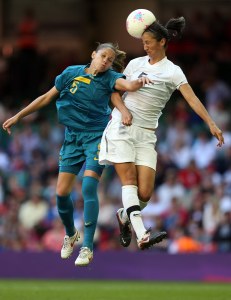 The much-travelled Emma Kete
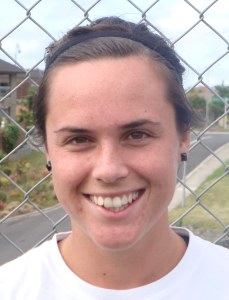 Rising stars Emma Rolston (left) and Briar Palmer with the writer
 |